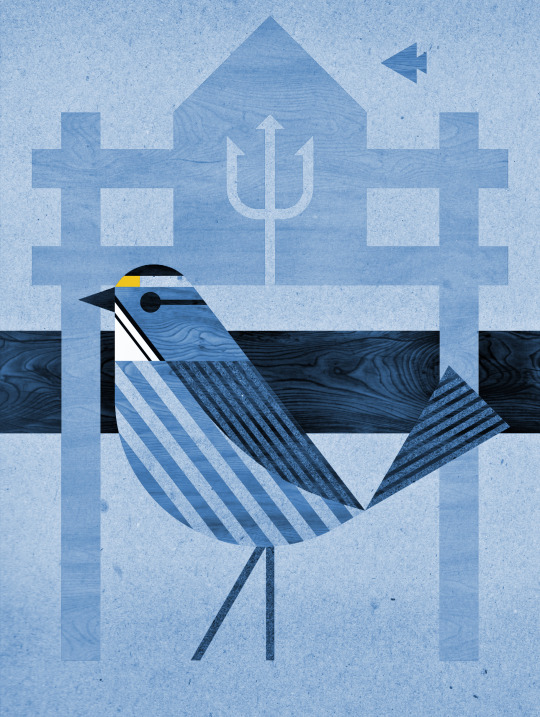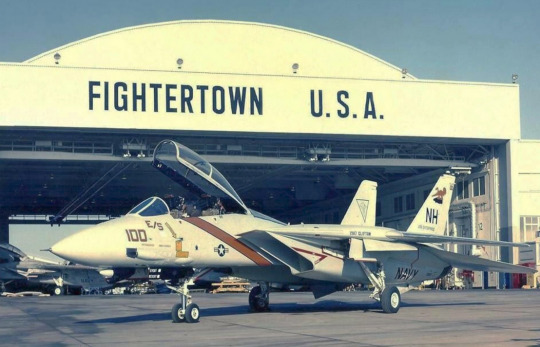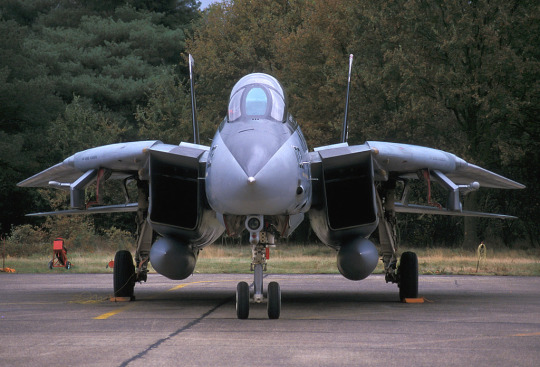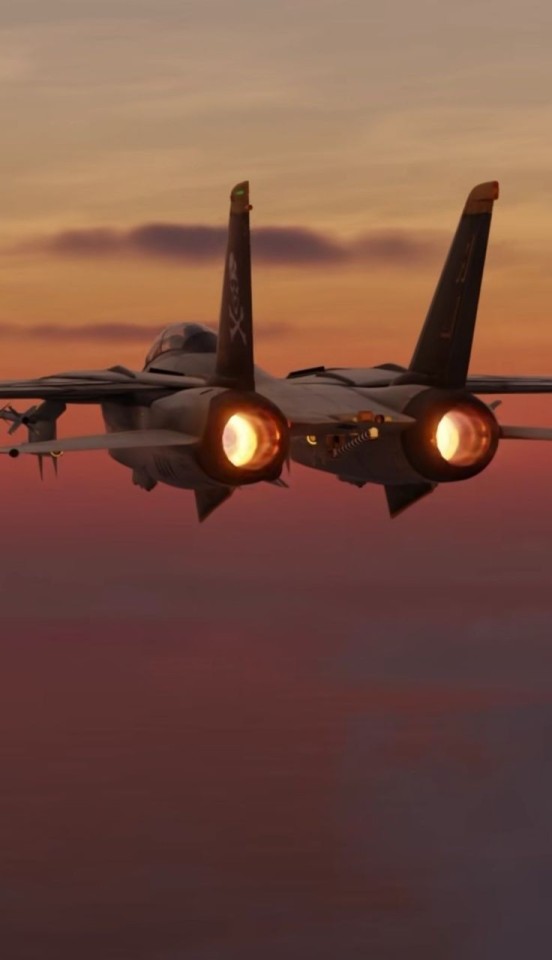#and f-14 tomcats
Explore tagged Tumblr posts
Text
F-14 TOMCAT ISSUES AND ACCIDENTS
The following is a compilation of issues with the F-14 Tomcat that have been encountered by pilots throughout its lifespan due to both mechanical and other reasons. Some are based on individual accidents and some cover epidemics in which many aircraft were lost to the issue *cough* compressor stalls *cough* basically it’s a bunch of ways you can hurt your fav characters in your fics so if you write something pls let me know cause I want to read it!!!
The issues range from minor hydraulic leaks to an explosion where pilots survive but the aircraft is literally in a million pieces.
LAST UPDATED 10/25/2023
Added some links to relavant FFFOTDs
Side note, the F-14 was a frickin massive tank of a fighter jet. She has taken damage to major components and still been able to land safely, so every situation is pretty unique.
Water Damage- Any type of water intrusion would cause issues with the electrical systems. It was a very common thing, so much so that they would have to duct tape anywhere water might be able to enter as a precaution when they knew it would rain.
Hydraulic Fluid Leaks - The F-14 did leak hydraulic fuel fairly often. There was a joke going around that if there isn't a bucket leaking hydraulic fluid underneath the plane then you are out of hydraulic fluid.
The Staple - On F-14 As and Bs, they would limit the jet to 4Gs maximum for three months and then they would install a metal staple to the bottom of the aircraft just forward of the tail hook. The point of the staple was to prevent severe bulkhead cracks and fuselage delamination by reducing the torquing moments caused by material fatigue. The staple is described as being a 1 foot-long and 1 inch wide solid steel part that looks exactly like a staple. As a part of their pre-flight checks, pilots would have to hang on it to ensure it wouldn’t fall out.
Airbags - Now and then, the airbags would rip and they would have to fix them.
Hydraulic Failures - Hydraulic failures happened somewhat often, but not often enough to be a prevalent issue. Generally speaking, it was common knowledge that if an F-14 wasn't leaking hydraulic fluid then it was out of hydraulic fluid. They would place buckets underneath to catch the liquid when the aircraft was not flying.
An incident from 1988 resulted from a complete hydraulic failure of both the main and the backup systems. They ruled the accident to be caused by the combination of failure of a relief valve and material failure. The Commander of the Pacific Fleet at the time believed that it could have possibly been the result of entrapped air that had been introduced into the hydraulic system through minor system maintenance.
AICS Programmers - They would have to start the airplane and then run the intake ramps aka would have to cycle the intake ramps otherwise they wouldn't be able to get off the ground.
Flap-Slat Lockout - If the flaps on either side of the jet didn't program at the same rate, it would cut it out and lock them up. They were then unable to move them as the lockout was a precaution to prevent asymmetry. This forced pilots to land without flaps, requiring an extra 22 knots during landing. It was difficult to land when they were locked out, and in many situations the end result would be pulling up next to the carrier and ejecting. Flap-Slat Lockout was a consistent issue throughout the Tomcat's life.
Unreliable Fire Warning Light - Sometimes the fire warning light would just barely start to flicker on and steadily become more prominent. Overall "just a bad system." You never actually know if there's a fire or not.
Wings Won’t Come Out - This happened at NAS Oceana. The airplane landed at a speed of 230 mph, so very close to the F-14’s stall speed. When the wings are stuck back, you can't hit the brakes during landing because there is no anti-skid and you would overheat them, if you pulled the stick back you would rotate, and with the wings back you have no spoilers so there is nothing to slow you down. In this particular incident, the pilot was able to take the long landing, but if this issue was encountered at sea it would require an ejection or divert to an airfield nearby if possible. No big explosions or fires though, it’d be a fairly calm procedure and the plane could fly into range of the ship for easy retrieval after ejection.
Low Fuel (Barricade Landing) - Bad weather at night combined with air traffic personnel being too occupied with diverting tons of airplanes, launching tankers, etc. can cause an aircraft to get low on fuel. There was a situation covered in the F-14 Tomcast episode called "F-14 Barricade" where they were unable to refuel using a tanker and were forced to do a barricade landing for their safety. They were almost forced to pull up alongside the carrier and eject. After the landing, one of the crew calculated based on the amount of fuel left that they only had about 90 seconds of flying left. This is literally the only night F-14 barricade landing ever I am pretty sure (in real life Maverick's doesn't count lol). I like it because the pilot and RIO had to tell the aircrew straight up "You have to take us now" because the pilot could no longer see the tape on the fuel gage. The crew tells their story really well and it’s really funny to listen to, especially considering the fact that they had to keep sending them around because they fucked up setting up the barrier.
Hitting the Canopy (During Ejection) - Goose's story is based on a real story in which a RIO hit the canopy during ejection and broke his spine. The reason the pilot does not also hit the canopy is because the ejection sends the RIO out first. The canopy is ejected after a couple of seconds after the handle is pulled, then the RIO is ejected after a second or two, and then the pilot another second later. The ejection seats also launch them in different trajectories so the pilot and the RIO do not collide in the air, meaning they may or may not end up in the same area. The solution would be to wait for the canopy to clear before ejecting but sometimes your don’t have that luxury.
Front Landing Gear Failure During Takeoff- While launching off of the catapult of the aircraft carrier, the nose gear attached to the shuttle broke. The landing gear and shuttle proceeded to the end of the runway without the jet, hitting the end of the ship at 305 knots and damaging the front of the carrier. The jet went off the ship with far less speed than necessary (at barely 60-70 knots) and began falling into the water as it was not enough to get the Tomcat in the air. They ejected to barely 50 feet high and were in serious danger of getting run over by the aircraft carrier. In the accident covered on the Fighter Pilot Podcast FPP004 - Ejection Seats, the RIO tells the story of his survival and the tragic loss of the pilot.
Radome (Nose Cone) Detachment - An F-14 Tomcat lost its radome during a flight due to the failure of the latching mechanism. The radome crashed into the canopy, shattering te glass of the windscreen. The pilot could only see out of a 3 inch hole in the windscreen due to the cracked windshield. He couldn't hear anything due to the noise of the wind in the cockpit, so he was unsure of the state of his RIO but assumed he was unconscious because he hadn't ejected them. The pilot flew over the carrier three times before successfully landing the plane, despite having glass in both eyes and a broken collarbone. It turns out that the RIO had been completely unharmed but with comms down he was unable to tell the pilot such. Upon landing the plane, the pilot was medevaced for eye surgery and then returned to the US.
Midair Collision - F-14A BUNo 159832 was a midair collision between two F-14 Tomcat. In this particular situation, one of the airplanes was able to divert to a nearby airport due to losing part of the right wing whereas the other crew was forced to eject. Obviously you could probably picture a situation where both jets went down.
Landng with Damage - Tomcats are a very sturdy aircraft, often described as being a tank both due to how much fuel they were able to carry and the sheer size of the aircraft. There has been an incident where an F-14 landed without one of its vertical stabilizers. In the Radome Deatchment section, the pilot was able to land the plane. The following video shows an aircraft, although not an F-14, landing aboard an aircraft carrier with significant damage on its right right side.
youtube
Single Engine Cat Shot- There was an incident where an aircraft had engine issues the moment it left the carrier. Immediately after the launch, they lost the left engine, and the first thing the pilot did was go through engine failure procedures, wingman at their side. They set up for an engine start using normal air before they attempted a cross-bleed air start using bleed air from the right engine to rotate the starter in the left engine, but neither worked. The pilot addressed the fuel distribution situation by feeding the right engine with fuel from the left to even them out and then they began dumping fuel to get to the "max trap" weight. Upon successfully landing, the Commanding Officer initially believed that the pilot had allowed the left engine throttle to roll back to idle during the acceleration of the catapult stroke, however, after maintenance personnel spun up the engine to troubleshoot, the engine spun well past its normal rpm immediately without the mechanical load it usually carried by the tower shaft meaning that something was very, very wrong. An image of the aircraft after launch can be seen below. Note the singular engine lit up.

F110 Afterburner Failure - The new engines installed were great, but they initially had a problem with the afterburner. In one recorded accident, the pilot lit the afterburner, damaging the afterburner can's lining and leading to an explosion. The Navy prohibited use of the afterburner below 10,000 ft on the F-14+/B/D until the problem could get solved but it took nearly a year to remedy.
"Thump Bang" - The easiest way to incorporate any sort of accident is to call it what the Naval Aviators call a "thump bang". A "thump bang" refers to a series of events that occur when an aircraft experiences some sort of issue they described as a "thump" and then an explosion. It's kind of hard to describe what is like in the cockpit during this sort of accident as it could have happened quickly or could have been a delayed explosion, and it could have been caused by any number of reasons. If they don't know what actually happened, they'll call it a "thump bang" and can only hypothesize what occurred. The likely scenario would have been an issue with the TF30 engines.
TF30 - The "Turd in the punch bowl, " the TF30s had two specific issues that were kind of intertwined.
Throwing Fan Blades - One of the largest issues with the TF30s was that they were with the fan blades. When the fan blades become eroded or damaged over time, they no longer compress the airflow efficiently, potentially leading to an engine stall (see Compressor Stall below). Additionally, the TF30 was known for "throwing" fan blades. This is when the fan blade becomes detached and is shot out to the side into the interior of the aircraft. Not good. Pretty bad actually. They didn't initially know they were throwing fan blades until after a couple of accidents. when they started to be more common they would retrieve the aircraft from the water (if in large enough pieces and then investigate the cause.
Compressor Stall - The actual biggest issue with the F-14 Tomcat and its TF30 engines is the compressor stalling. They literally happened all the time from a variety of different causes. Generally speaking, the compressor stalls were the result of disruption to the airflow into the compressor of the engine. The compressor has fan blades that require the airflow to be undisturbed for maximum efficiency. It was theorized to be the result of foreign object debris (FOD) ingestion into the engines. They check religiously for loose objects on the airplanes as a result, oftentimes having a crew member dive into the intake ducts to check for loose bolts. Additionally, compressor stalls could be caused by operating the aircraft outside of its limits, improper handling, etc.
The F-14 had a gated afterburner, meaning it had 5 “gates” inside of the afterburner and each one lit up a flame rack. There was no variable thrust, so it had to be either on or off. Each of the five racks was labeled as a zone. Zone 3 is what they were allowed to take off with. Coming in or out of afterburner with any angle or attack would cause the compressor to immediately stall. This was mostly due to poor design of the intake.
In general, approximately 30% of F-14A losses were attributed to high-altitude compressor stalls. When one engine stalls, more often than not it will induce the other engine to stall as well. There is a procedure to counteract the compressor stall, the specific protocol was to ease the amount of Gs, slow down, the T.I.T. would go crazy and you shut it down. Or in fighter pilot slang, “ease, slow cook it, shut it down.”
One incident in particular that was assumed to be caused by engine failure resulted in an explosion that looked so bad it was a miracle the pilot and RIO survived (see image below). The pilot escaped with minor burns to his hands, face, and neck and was able to fly within a couple of weeks. The RIO sustained more serious burns on his hands but was flying again after several weeks.
youtube
youtube
Not Touching Them For Two Days - True story; they flew best when they were used a lot.
#I’ll be your wingman anytime#fanfic writing wingman that is#it’s my birthday and all I want is for people to tag me when my posts help you because I want to read them!!!!!#I’m obsessed#I like angst#and airplanes#angst and airplanes#I like research#and f-14 tomcats#top gun#tom kazansky#top gun: maverick#iceman#top gun maverick#top gun iceman#pete mitchell#icemav#my boys#ron kerner#tgm#research#Youtube#mine#I like planes#tom iceman kazansky#just a little thing I wrote#EDIT 10/6: Expanded Hydraulic Failure section and added the single engine cat shot section#reference#f 14 tomcat has ✨issues✨#information
206 notes
·
View notes
Text

1K notes
·
View notes
Photo




(via This Is What Grumman's Proposed F-14 Super Tomcat 21 Would Have Actually Looked Like)
446 notes
·
View notes
Text
Grumman F-14 Tomcat
The F-14 Tomcat is a supersonic, twin-engine, two-seat, variable-sweep wing fighter aircraft designed for carrier-based operations. It was developed by Grumman Aerospace Corporation (now part of Northrop Grumman) for the United States Navy and first entered service in the 1970s.
It was regarded as one of the most iconic and versatile fighter jets of its time.

355 notes
·
View notes
Text

a U.S. Navy F-14A attached to the FREELANCERS on combat patrol during ODShield Jan. 1991. USN
@kadonkey via X
#f 14 tomcat#grumman aviation#fighter interceptor#aircraft#navy#aviation#us navy#carrier aviation#anytime baby#cold war aircraft
208 notes
·
View notes
Text

460 notes
·
View notes
Text

F-14 Tomcat carrier take off
716 notes
·
View notes
Text

756 notes
·
View notes
Text

The Seaside Sparrow, Ammodramus maritimus, under the pier at Virginia Beach.
496 notes
·
View notes
Text

Tomcat at Top Gun - 1988
#military#aircraft#air force#us air force#usaf#fighter jet#aviation#fighter plane#us navy#plane#f 14 tomcat#f14 gil#usn#navy#northrop grumman#grumman#VF-114#Miramar#fightertown#military aircraft#jet#top gun maverick#Top Gun#top gun 1986#usa
292 notes
·
View notes
Text

A US Navy Tomcat from VF-103 Jolly Rogers parked at Kleine Brogel Air Base, Belgium - Oct 2000
#USN#Navy#Grumman#F-14#Tomcat#Military aviation#Fighter#aircraft#VF-103#Jolly Rogers#combat aircraft#jet#plane
322 notes
·
View notes
Text

518 notes
·
View notes
Text

F-14 Tomcat
592 notes
·
View notes
Text

“Maverick. You’re where you belong, make us proud”- Admiral Bates
#top gun maverick#pete maverick mitchell#admiral bates#top gun warlock#solomon warlock bates#top gun quotes#f 14 tomcat#fighter pilot#sunset painting
108 notes
·
View notes
Text
middle aged veterans and history buffs whose special interest is planes 🤝 gen z girls and gays who know that an f-14 is a plane because of top gun
#it’s me I’m girls and gays#top gun movie#top gun 1986#top gun#top gun maverick#tg86#tgm#pete maverick mitchell#gay military#gay pilots#planes#f 14 tomcat#top gun fandom#emme’s bad ideas
363 notes
·
View notes
Text

A VF-32 F-14A arrives home from Desert Storm for homecoming ceremonies. March 1991. NAS Oceana. (Joe Mancias)
@kadonkey via X
#f 14 tomcat#grumman aviation#fighter interceptor#aircraft#navy#aviation#us navy#carrier aviation#anytime baby!#cold war aircraft
216 notes
·
View notes